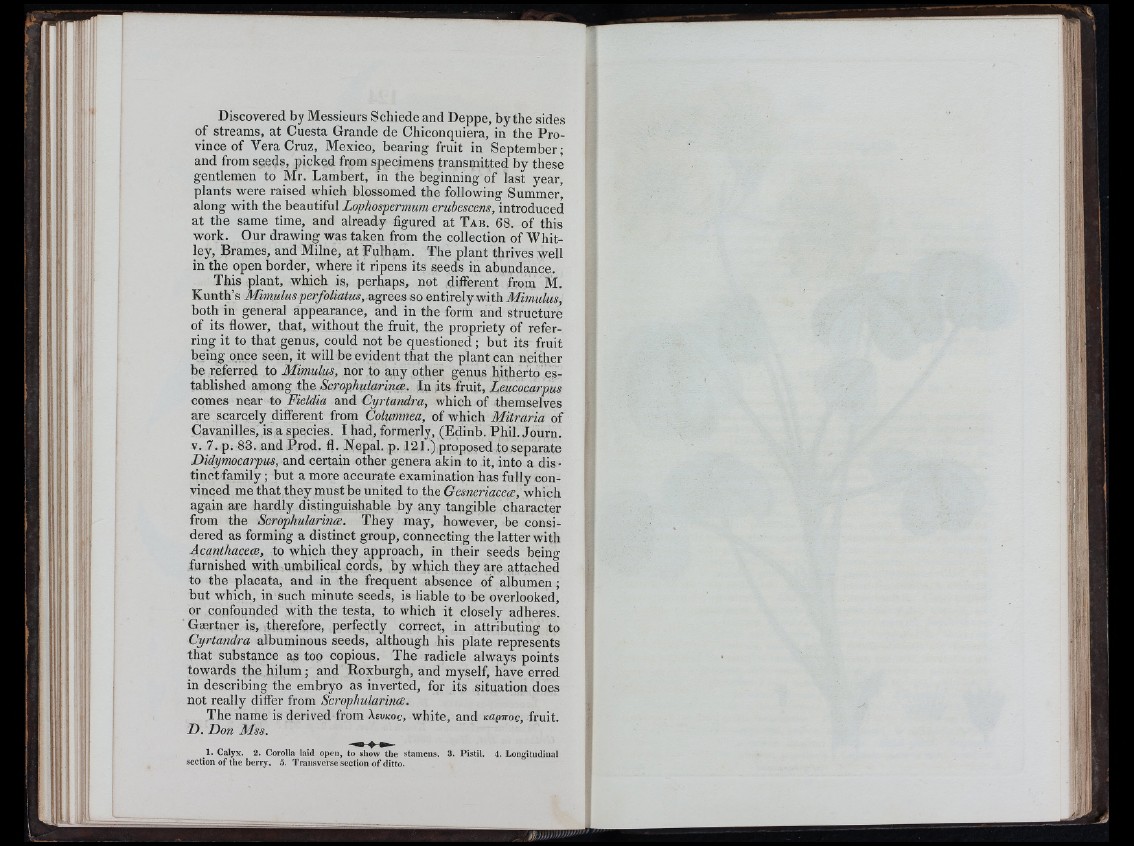
Discovered by Messieurs Schiede and Deppe, by the sides
of streams, at Cuesta Grande de Chiconquiera, in the Province
of Vera Cruz, Mexico, bearing fruit in September;
and from seeds, picked from specimens transmitted by these
gentlemen to Mr. Lambert, in the beginning of last year,
plants were raised which blossomed the following Summer’
along with the beautiful Lophospermum erubescens, introduced
at the same time, and already figured at T a b . 6 8 . of this
work. Our drawing was taken from the collection of Whitley,
Brames, and Milne, at Fulham. The plant thrives well
in the open border, where it ripens its seeds in abundance.
This plant, which is, perhaps, not different from M.
Kunth’s Mimulus perfoliatus, agrees so entirely with Mimulus,
both in general appearance, and in the form and structure
of its flower, that, without the fruit, the propriety of referring
it to that genus, could not be questioned ; but its fruit
being once seen, it will be evident that the plant can neither
be referred to Mimulus, nor to any other genus hitherto established
among the Scrophularince. In its fruit, Leucocarpus
comes near to Fieldia and Cyrtandra, which of themselves
are scarcely different from Columnea, of which Mitraria of
Cavanilles, is a species. I had, formerly, (Edinb. Phil. Journ.
V. 7. p. 83. and Prod. f l . Nepal, p. 121.) proposed to separate
Didymocarpus, and certain other genera akin to it, into a dis tinct
family; but a more accurate examination has fully convinced
me that they must be united to the Gesneriacece, which
again are hardly distinguishable by any tangible character
from the Scrophularince. They may, however, be considered
as forming a distinct group, connecting the latter with
AcanthacecB, to which they approach, in their seeds being
furnished with umbilical cords, by which they are attached
to the placata, and in the frequent absence of albumen ;
but which, in such minute seeds, is liable to be overlooked,
or confounded with the testa, to which it closely adheres.
CcErtner is, therefore, perfectly correct, in attributing to
Cyrtandra albuminous seeds, although his plate represents
that substance as too copious. The radicle always points
towards the hilum; and Roxburgh, and myself, have erred
in describing the embryo as inverted, for its situation does
not really differ from Scrophularince.
The name is derived from Aewoc, white, and xapTroc, fruit.
D . Don Mss.
1. Calyx. 2. Corolla laid open, to show th e stamens. 3. Pistil. 4. Longitudinal
section o f th e berry. .5. Transverse section o f ditto.
f|
m;11'l